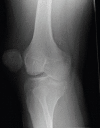Atraumatic Extra-articular Patellar Dislocation with Vertical Axis Rotation: A Case Study
- PMID: 27299129
- PMCID: PMC4845415
- DOI: 10.13107/jocr.2250-0685.378
Atraumatic Extra-articular Patellar Dislocation with Vertical Axis Rotation: A Case Study
Abstract
Introduction: Acute patellar dislocation is a common injury usually associated with a significant traumatic mechanism resulting in lateral displacement. Vertical axis rotation following dislocation is a rare variant of this type of injury and can prevent closed reduction in the acute setting.
Case presentation: A 32-year old gentleman presented with an irreducible patella dislocation following an unusual atraumatic mechanism. Following attempts at closed reduction under sedation and regional nerve block, eventual open reduction and soft tissue reconstruction was required under general anesthetic. During the open reduction procedure, it was noted that the patella had dislocated into a lateral extra-articular position and rotated around its vertical axis. Following patella reduction, the medial patellar retinaculum was repaired. Examination under anesthetic revealed satisfactory tracking of patella following repair.
Conclusion: A review of the literature suggests dislocations such as the current presentation, are extremely rare and although have been described to occur with minor trauma, have never been described to occur following a largely atraumatic event. In such cases, closed reduction may be impossible even with adequate analgesia due to patella position and soft tissue obstruction. Open reduction is essential in these situations.
Keywords: Patellar Reduction; Patellar dislocation; vertical axis rotation.
Conflict of interest statement
Conflict of Interest: Nil
Figures




References
-
- Cooper A. A treatise on dislocations and fractures of the joints. Lea & Febiger, Philadelphia; 1844. p. 178.
-
- Corso SJ, Thal R, Forman D. Locked Patellar Dislocation With Vertical Axis Rotation: A Case Report. Clinical orthopaedics and related research. 1992;279:190–193. - PubMed
-
- Yang C, Gong Y, Wen X, et al. Extra-articular patellar dislocation with vertical axis rotation. The Knee. 2011;18(6):512–513. - PubMed
-
- Sherman SC, Yu A. Patellar dislocation with vertical axis rotation. Journal of Emergency Medicine. 2004;26(2):219–220. - PubMed
-
- Hackl W, Benedetto KP, Fink C, et al. Locked lateral patellar dislocation: a rare case of irreducible patellar dislocation requiring open reduction. Knee Surgery, Sports Traumatology, Arthroscopy. 1999;7(6):352–355. - PubMed
Publication types
LinkOut - more resources
Full Text Sources
